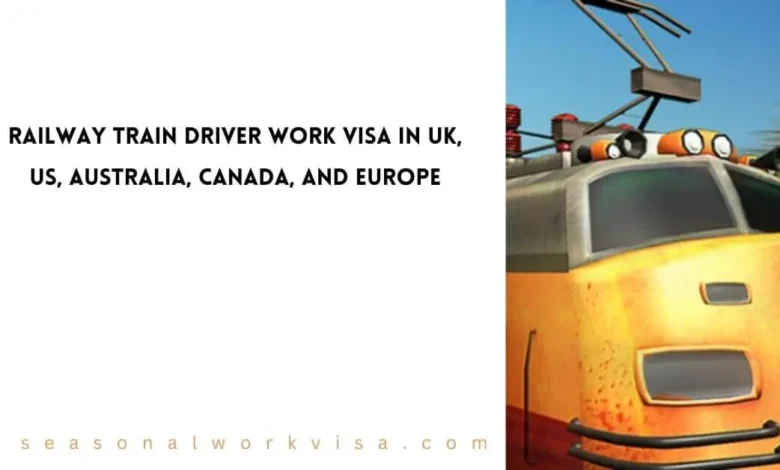Railway Train Driver Work VISA in UK, US, Australia, Canada

Imagine being at the helm of a high-speed bullet train, overseeing its smooth operation, or ensuring freight reaches its destination safely. Becoming a train driver is not only a prestigious job but also one that offers diverse opportunities for advancement and travel. This guide will walk you through everything you need to know to pursue a career as a train driver, covering job prospects, qualifications, salary comparisons, and career paths across countries including the UK, US, Canada, Australia, and Europe.
Check Also: Electrician Jobs in Canada with Visa Sponsorship
Why Become a Train Driver?
Train driving isn’t just about controlling a train; it’s about embracing a career that combines responsibility, technology, and adventure. As a train driver, you’ll be responsible for the safe and timely operation of trains, from commuter lines to high-speed intercity routes. Each journey can be different, making it an exciting and dynamic career choice.
How to Get Started: Required Qualifications and Eligibility Criteria:
Before embarking on your journey as a train driver, you’ll need to meet some basic qualifications and undergo extensive training. Here’s a detailed breakdown:
1. Education:
- Minimum Requirement: A high school diploma or equivalent is typically required. This serves as the foundation for further technical training.
- Preferred Qualifications: While a high school diploma is sufficient, additional qualifications in subjects like mathematics, physics, or engineering may be beneficial. Some employers also look for experience in related fields, such as mechanics or electronics.
2. Training Programs:
Train driver training is thorough and can last anywhere from a few months to more than a year, depending on the country and the type of train you will operate.
- Classroom Instruction: Learn the theoretical knowledge, including railway safety, signaling, operational procedures, and local railway regulations.
- Simulator Training: Practice in a safe, controlled environment to familiarize yourself with train controls and emergency procedures.
- Real-life Training: In the final stage of training, you’ll ride along with experienced drivers, gaining hands-on experience in real-world scenarios.
3. Licensing and Certification:
To become a qualified train driver, you must pass a combination of written and practical exams, often administered by national or regional railway authorities.
- Written Exams: These test your knowledge of railway operations, safety standards, and technical systems.
- Practical Tests: After completing training, you’ll demonstrate your ability to operate a train under supervision.
Licensing Systems by Country:
- United Kingdom: In the UK, drivers must obtain certification from the Office of Rail and Road (ORR).
- United States: In the US, the Federal Railroad Administration (FRA) sets the standards for training and certification.
- Australia: Australian train drivers must obtain Certificate IV in Train Driving.
- Canada: Canadian drivers are regulated by the Canadian Railway Operating Rules (CROR).
4. Health and Medical Requirements:
Train driving is a physically demanding job that requires excellent health. You’ll need to undergo regular medical checks to ensure you meet the following standards:
- Good vision and hearing: Crucial for monitoring signals and controlling the train.
- Physical fitness: Required to handle long shifts and remain alert.
- Mental health: Regular screenings ensure you are mentally fit to make critical decisions in high-pressure situations.
Salary Comparison: How Much Do Train Drivers Earn?
Salaries for train drivers vary significantly depending on the country, the type of train, and your level of experience. Here’s a breakdown of average salaries for train drivers in various countries:
- United States: $57,790 per year on average.
- Canada: Between C$65,000 and C$85,000 per year, depending on experience and location.
- United Kingdom: £48,500 per year on average.
- Australia: A$70,000 – A$100,000 per year.
- New Zealand: NZ$65,000 – NZ$85,000 per year.
- Turkey: ₺150,000 – ₺300,000 per year.
- Germany: €35,000 – €60,000 per year.
- France: €30,000 – €50,000 per year.
Salaries tend to increase with experience and the type of train being driven. For example, high-speed rail drivers or freight train operators often earn more due to the technical skills and responsibility required.
Benefits:
The benefits of being a train driver go beyond just a paycheck. Here are some key perks:
- Job Security: Rail companies around the world need qualified drivers, ensuring long-term job stability.
- Social Benefits: Most countries offer healthcare, pension plans, paid time off, and other social benefits to train drivers.
- Career Advancement: Many railway companies offer opportunities for advancement into supervisory roles, or specialized positions such as train operations manager or safety officer.
- Travel Opportunities: Some companies offer free or discounted train travel for employees, making it an excellent job for travel enthusiasts.
Career Progression: Advancing in the Railway Industry:
Starting as a train driver, there are numerous opportunities to climb the career ladder. Here are a few common paths:
- Lead Driver/Driver Trainer: After gaining substantial experience, you can become a Lead Driver, responsible for overseeing a team of drivers and ensuring safe operations.
- Operations Supervisor: Some train drivers move into roles where they supervise train operations, ensuring schedules are met and safety protocols are followed.
- Specialized Roles: You could specialize in areas such as high-speed rail, freight logistics, or railway safety.
Many railway companies also offer internal training programs to help drivers transition into management or technical roles. For example, you may be trained as a train controller or to handle more complex tasks in railway infrastructure maintenance.
Where to Find Train Driver Jobs Abroad?
Finding a job as a train driver abroad can be an exciting opportunity, especially with the global demand for skilled railway workers. Here are some top resources for finding jobs in different regions:
- United Kingdom: National Rail Enquiries, Reed, Network Rail
- United States: Amtrak Careers, the Railroad Retirement Board, job boards like Indeed and LinkedIn
- Canada: CN Careers, CP Rail, and the Government of Canada Job Bank
- Australia: Seek, individual rail operators like Aurizon and Pacific National
- Europe: EURES, Deutsche Bahn, SNCF, Trenitalia
Each country has its own hiring process, which often involves application through national rail operators or regional job portals.
Visa and Relocation: Working as a Train Driver Abroad:
For international job seekers, obtaining a work visa is a crucial step. Here’s what you need to know:
- Eligibility for Work Visas: Train drivers are considered skilled workers in many countries, and there may be specific visa pathways available for them.
- Visa Flexibility: Some countries allow workers to transfer between different sectors within the same company or industry. For example, a railway driver working in Germany could transfer to France within the same European railway network.
- Family Relocation: Certain work visas allow for family members to accompany the worker, providing a path for relocation.
Visa Requirements by Country:
- United States: You can apply for a work visa under the H-2B or H-1B program, depending on qualifications.
- Canada: The Temporary Foreign Worker Program (TFWP) may be an option for international candidates.
- Australia: Applicants may apply for a Skilled Independent Visa (subclass 189) if they meet specific qualifications.
- Europe: The EU Blue Card provides skilled workers with opportunities across member states.
Conclusion: Ready to Start Your Journey?
Becoming a train driver offers a great career with competitive pay, job security, and exciting advancement opportunities. Whether you’re interested in working in passenger services, freight, or high-speed rail, there’s a range of paths available to you, depending on where you live and your goals. The training process might seem long, but with the right qualifications and dedication, the rewards are more than worth it.
Start your journey by researching training programs in your region and exploring job opportunities worldwide. And who knows? The next stop on your career journey could be driving a high-speed bullet train across Europe or managing operations in one of the world’s busiest railways.
Frequently Asked Questions:
What qualifications are needed to become a train driver?
To become a train driver, you generally need a high school diploma or equivalent, extensive training, and relevant licensing and certification. A clean criminal record and good driving history are also essential.
How long does train driver training take?
Train driver training can range from a few months to over a year, depending on the country and type of train. It includes classroom instruction, simulator practice, and real-life training with a qualified driver.
Where do train drivers work?
To start their workday, train drivers have to get to rail depots and reside within a 45-minute to an hour radius of their base depot. They will continue to operate the train until they arrive at their intended destination. Overnight accommodation may be required at the conclusion of a run once that has been achieved.




